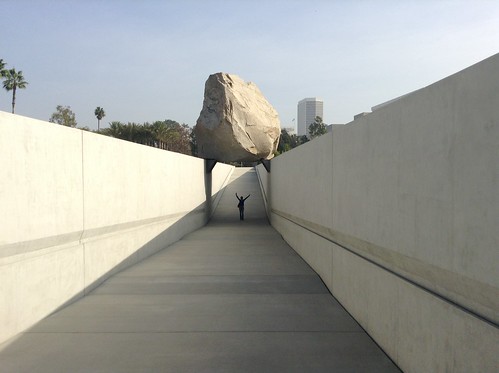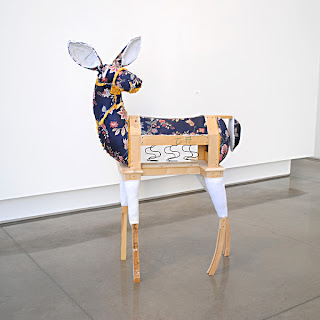It seemed the great majority of opinions formed around Michael Heizer's instantly famous sculpture, installed last year at the Los Angeles County Museum of Art, had been decided well in advance of it's actual creation. In the extreme cases, it was either the greatest thing to happen in four thousand years, or the worst possible thing anyone could ever do with a boulder. Mostly though it was just a novelty of engineering, of the effort involved in moving an object so heavy through a cityscape so sprawling — and how expensive that was. Christopher Knight, writing for the LA Times, produced an interesting analysis of the phenomenon, and was, as far as I have found, the only person to note in print that all of the judgements, whatever else they were, were coming in a little bit prematurely. "I can't tell you how many people have asked whether I like a sculpture that doesn't yet exist," he wrote last March, three months before the piece was finally unveiled.
For those who did reserve their judgements for a finished product, the reaction was middling. Many, as is usual, preferred to make no judgement, and again report on the process of bringing the piece to fruition, or the ceremony of the opening, but for those who chose to write about the earthwork itself, Knight once again provides an appropriately representative sample: "Huge advance publicity set up a love-it-or-hate-it anticipation for either a masterpiece or a fiasco. But this work is neither." Having now seen the work myself, I am inclined to agree, but the question then is why.
First it should be reiterated that the boulder itself is not the artwork. In other words, don't just go glance at the rock and proclaim dissatisfaction — or, for that matter, not go and still proclaim dissatisfaction. Rather, this piece seems to be about the experience of approaching and walking under the boulder through the concrete trench — just about being everywhere called a "slot" — that forms the lower portion of this large earthwork sculpture, along with the hardware holding the rock in place, namely a pair of heavy steel shelves bolted to the trench walls and the boulder. The surrounding field of decomposed granite serves mostly as a framing device, directing the focus to what is inside the trench, not out.
Much criticism has sprung from the title of the piece, Levitated Mass, which, if for some reason you're inclined to take the title of an artwork literally, promises that the famously massive boulder will float in midair, or at least present the illusion of floating. And then there was LACMA Director Michael Govan promising repeatedly ahead of time that the title was indeed to be taken literally. "The piece is actually called Levitated Mass, because, as you walk down the ramp, it will appear that the rock is levitating," he states in a YouTube video released by the museum before the rock moved from its quarry. Govan has not been one to hold back, either in his advance proclamations or subsequent praise for the piece, so it may not be surprising that it doesn't quite live up to his promises. My favorite analysis on this point comes from a deadpan Wikipedia contributor, taking a little bit more liberty than Wikipedians are generally afforded, writing, "Initial plans for the work described the boulder as being affixed to the trench walls themselves, giving the boulder the appearance of 'floating' when viewed from within the trench via optical illusion, hence the work's title. With the addition of the support shelves, this illusion does not occur." Another way of looking at it could be that the boulder does not appear to levitate any more than the ceiling in your home does when you walk down the stairs, but the writer is on to something in citing the shelves.
Ignoring the the title of Levitated Mass, we should evaluate the piece, as we would any other, based upon the reality it proposes. And what seems to be proposed, standing under the two story boulder, is that a feeling of uneasiness should set in. No, we shouldn't suspend our disbelief to think the rock is levitating, but its purchase should feel uncertain, sort of the way Richard Serra's best sculptures bend the space around themselves, disorienting viewers and seeming on the point of toppling. As it stands now, Wikipedia is on the mark. The great steel brackets lend too much stability, relegating the megalith oddly to the status of a giant knick knack, placed carefully on the mantle.
Curiously, only architectural publications have seen fit to delve into the compromises made in constructing this piece. Architectural Record notes, "The design and engineering team had to balance Heizer’s vision with the safety of the public," and goes on to describe some of the earthquake safety measures implemented in the construction. And in The Architect's Newspaper, a more exhaustive list:
Many of the design details of Levitated Mass prioritized technical requirements above aesthetics. The cement trench rises above the decomposed granite of the surrounding grounds to waist height—otherwise the building code would have required a glass railing. ADA-mandated handrails make an unavoidable contribution to the interior of the trench. And two of the concrete trench’s more noticeable characteristics have more to do with nuisance abatement than artistic panache: the skimcoat cover on the concrete will make graffiti easy to wash away and recoat, and triangle notches on both ends of the trench are meant to keep skateboarders off the concrete.
All of these elements have an effect on the experience of the piece, and one wonders if these compromises could have been mitigated? Why, for example, didn't the ADA mandated handrails simply continue to the top of the trench? They would then have appeared more as a conscious design element than regulatory accommodation. And indeed, why aren't the trench walls closer together so as to support the boulder directly? One imagines that the bolts holding the rock in place could have been disguised somehow.
As with any artwork, such speculation is just a critical exercise, since the piece is already made and not going anywhere — this one more than most. I wouldn't go quite so far as Christopher Knight in calling this piece "good". The word that comes to my mind instead is 'fine'. It's just a shame that in a piece designed to dominate a landscape for hundreds, or, it's been suggested, thousands of years, the compromise stands out just a little bit more than the vision.











